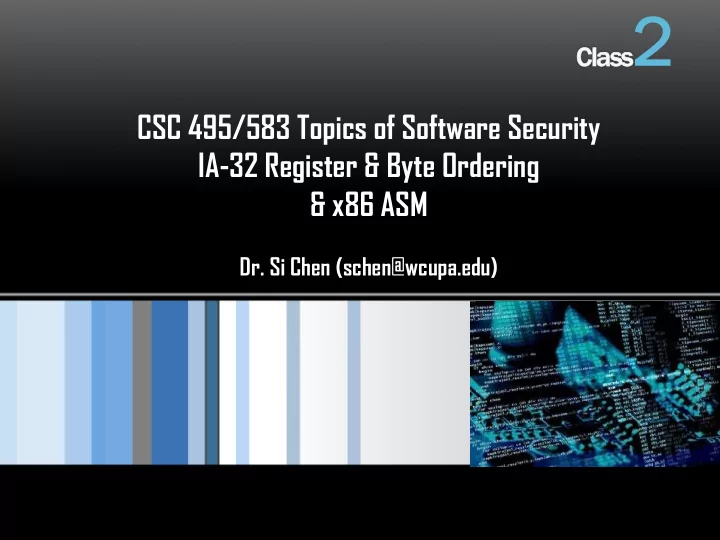

ss 2 Cl Class CSC 495/583 Topics of Software Security IA-32 Register & Byte Ordering & x86 ASM Dr. Si Chen (schen@wcupa.edu)
Badger CTF Your Computer § IP: roadrunner.cs.wcupa.edu § Username: ss2020 Roadrunner § Password: wcupa2020 § IP: 144.26.62.186 Badger CTF § Username: student § Password: ss2020 Page § 2
IA-32 Register Page § 3
Intel IA-32 Processor § Intel uses IA-32 to refer to Pentium processor family, in order to distinguish them from their 64-bit architectures. Page § 4
Register Set § There are three types of registers: – general-purpose data registers, – segment registers, – status and control registers. Page § 5
General-purpose Registers § The eight 32-bit general-purpose data registers are used to hold operands for logical and arithmetic operations, operands for address calculations and memory pointers 4 Bytes Page § 6
Other uses… – EAX—Accumulator for operands and results data. – EBX—Pointer to data in the DS segment. – ECX—Counter for string and loop operations. – EDX—I/O pointer. 1. We use these four registers when we perform arithmetic operations (ADD, SUB, XOR, OR) -- store constant or variable’s value. 2. Some assembly operations (MUL, DIV, LODS) directly operate these register and altered the value when finished. 3. ECX is used for loop count à decrease 1 after each loop 4. EAX is used for storing the return value of a function (Win32 API) Page § 7
Other uses… § ESI—Pointer to data in the segment pointed to by the DS register; source pointer for string operations. § EDI—Pointer to data (or destination) in the segment pointed to by the ES register; destination pointer for string operations. § EBP—Pointer to data on the stack. § ESP—Stack pointer. PUSH, POP, CALL, RET Page § 8
Segment Registers § There are six segment registers that hold 16-bit segment selectors. A segment selector is a special pointer that identifies a segment in memory. – CS: code segment register – SS: stack segment register – DS, ES, FS, GS: data segment registers Page § 9
Status and Control Registers The 32-bit EFLAGS register contains a group of status flags , a control flag , and a group of system flags . JCC Page § 10
Status and Control Registers Change to ‘1’ if: • Signed integer overflow • Change in MSB (Most Significant Bit) Change to ‘1’ if: • Calculation result is 0 Change to ‘1’ if: • unsigned integer overflow Page § 11
Status and Control Registers EIP Register (Instruction Pointer) The EIP register (or instruction pointer) can also be called " program counter ." It contains the offset in the current code segment for the next instruction to be executed . It is advanced from one instruction boundary to the next in straight-line code or it is moved ahead or backwards by a number of instructions when executing JMP, Jcc, CALL, RET, and IRET instructions. Page § 12
Byte Order Page § 13
Little endian § IA-32 processors use "little endian" as their byte order. This means that the bytes of a word are numbered starting from the least significant byte and that the least significant bit starts of a word starts in the least significant byte. Page § 14
Byte Order Page § 15
little_endian.c Page § 16
X86 ASM Page § 17
MOV § Move reg/mem value to reg/mem – mov A, B is "Move B to A" (A=B) – Same data size mov eax, 0x1337 mov bx, ax mov [esp+4], bl Page § 18
MOVZX / MOVSX § From small register to large register § Zero-extend (MOVZX) / sign-extend (MOVSX) § Example: movzx ebx, al Page § 19
More About Memory Access § mov ebx, [esp + eax * 4] Intel § mov (%esp, %eax, 4), %ebx AT&T § mov BYTE [eax], 0x0f You must indicate the data size: BYTE/WORD/DWORD Page § 20
ADD / SUB § ADD / SUB § Normallly "reg += reg" or "reg += imm" § Data size should be equal – ADD eax, ebx – sub eax, 123 – sub eax, BL ; Illegal Page § 21
INC / DEC § inc, dec — Increment, Decrement § The inc instruction increments the contents of its operand by one. The dec instruction decrements the contents of its operand by one. § Syntax inc <reg> inc <mem> dec <reg> dec <mem> § Examples DEC EAX — subtract one from the contents of EAX. INC DWORD PTR [var] — add one to the 32-bit integer stored at location var Page § 22
SHL / SHR / SAR § Shift logical left / right § Shift arithmetic right § Common usage: SHL eax, 2 (when calculate memory address) Page § 23
Jump § Unconditional jump: jmp § Conditional jump: je/jne and ja/jae/jb/jbe/jg/jge/jl/jle ... § Sometime with ”cmp A, B” -- compare these two values and set eflags § Conditional jump is decided by some of the eflags bits. Page § 24
Jump § ja/jae/jb/jbe are unsigned comparison § jg/jge/jl/jle are signed comparison Page § 25
CMP § cmp — Compare § Compare the values of the two specified operands, setting the condition codes in the machine status word appropriately. This instruction is equivalent to the sub instruction, except the result of the subtraction is discarded instead of replacing the first operand. Syntax cmp <reg>,<reg> cmp <reg>,<mem> cmp <mem>,<reg> cmp <reg>,<con> § Example cmp DWORD PTR [var], 10 jeq loop § If the 4 bytes stored at location var are equal to the 4-byte integer constant 10, jump to the location labeled loop . Page § 26
Page § 27
Recommend
More recommend